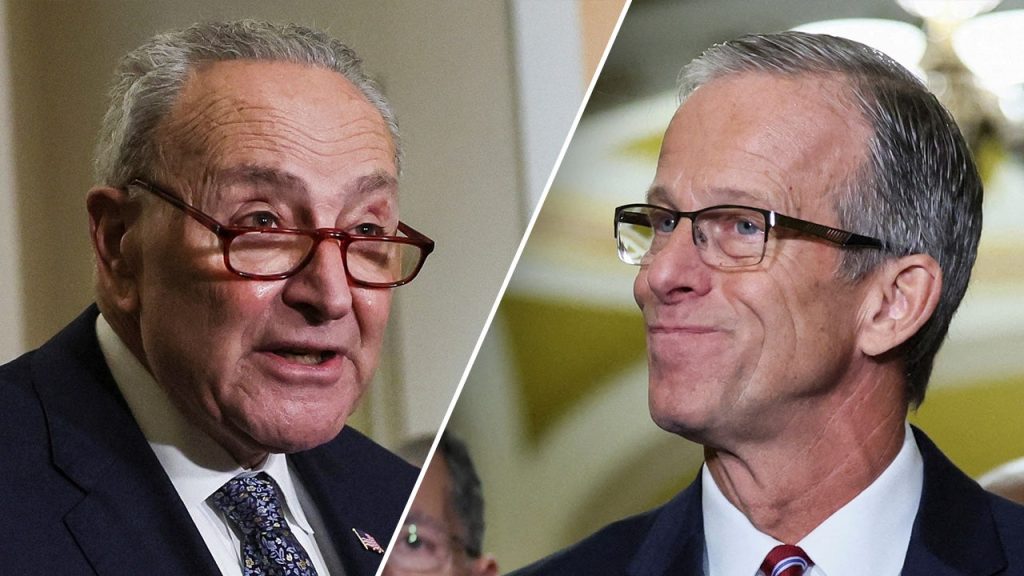As the deadline for a government shutdown looms, the U.S. Senate has moved to advance a stopgap spending bill that aims to maintain current spending levels through the end of fiscal year 2024. In a pivotal vote on Friday, the measure passed with a decisive 62-38 margin, garnering bipartisan support as ten Democrats joined Republicans to break the filibuster. This legislative action comes amidst deep divisions within the Democratic Party, as some members openly voiced their opposition to the bill, creating a tense atmosphere leading up to the crucial procedural vote.
| Article Subheadings |
|---|
| 1) Senate Votes to Advance Stopgap Bill Amid Deadline Pressure |
| 2) Bipartisan Support Aids Bill’s Progression |
| 3) Tensions Rise Within the Democratic Party |
| 4) The Stakes of a Government Shutdown |
| 5) Future Implications of Current Legislative Actions |
Senate Votes to Advance Stopgap Bill Amid Deadline Pressure
On Friday, the Senate successfully voted 62-38 to advance a short-term spending bill, a crucial step in preventing a government shutdown. The measure, known as a continuing resolution (CR), proposes to keep federal funding levels constant until October 1, 2024. It requires bipartisan support to overcome the 60-vote procedural hurdle typically needed for legislation to proceed. Senate Minority Leader Chuck Schumer (D-NY) and Minority Whip Dick Durbin (D-IL) were among those who publicly expressed their intention to vote for the bill, breaking ranks with some members of their party in the interest of keeping the government operational.
Bipartisan Support Aids Bill’s Progression
A notable aspect of the voting dynamics was the cooperation between Democrats and Republicans. A total of ten Democrats sided with the nearly unanimous Republican contingent to push the bill through, showcasing an effort to avert a government shutdown that could have severe consequences for federal operations. In particular, the Senate’s Republican leadership, which holds only 53 seats, needed these Democratic votes due to the holdout of some party members, including Senator Rand Paul (R-KY), who expressed his opposition to the bill. The collaboration was characterized as necessary by many Republican senators, who warned that failing to pass the CR would lead to significant disruptions in government services.
Tensions Rise Within the Democratic Party
Despite the overall success in moving the bill forward, significant discord emerged within the Democratic caucus. In the lead-up to the pivotal vote, Democrats engaged in heated discussions, with individuals such as Kirsten Gillibrand (D-NY) reportedly expressing strong concerns about the direction of the negotiations. The party faced internal fractures, with some members firmly opposed to the stopgap bill, believing it does not adequately address their goals or reflect the needs of their constituents. This rift has drawn attention to how the party reconciles its progressive elements with more centrist views, particularly in an election year when unity and voter support are critical.
The Stakes of a Government Shutdown
The imminent possibility of a government shutdown looms large in political discussions. If the bill were not passed by the deadline of 11:59 p.m. on Friday, the government would have had to implement partial shutdown measures, potentially leading to furloughs of federal employees and suspension of various government services. Senators, particularly from states heavily reliant on federal funding, expressed the urgency of maintaining government operations to avoid detrimental impacts on their constituents, including delays in services and economic disruptions that could stem from a lack of federal funding.
Future Implications of Current Legislative Actions
Looking ahead, the discussions surrounding this stopgap bill set a precedent for future negotiations. The cooperation across party lines raises questions about what compromises might be necessary as budget discussions continue into the next fiscal year. Some lawmakers warn of the potential fallout if party leaders fail to find a way to unite differing factions within their ranks. The significance of the current legislation is underscored by the potential consequences of further conflict, which could destabilize government functionalities and harm public trust in governance.
| No. | Key Points |
|---|---|
| 1 | The Senate voted 62-38 to advance a stopgap spending bill, crucial for preventing government shutdown. |
| 2 | Bipartisan support was evident, with ten Democrats joining Republicans to overcome the filibuster. |
| 3 | Internal tensions were highlighted in the Democratic Party over the approach to the stopgap bill. |
| 4 | A government shutdown could have led to furloughs and disruptions in federal services. |
| 5 | The outcome of this vote could affect future legislative negotiations and party dynamics. |
Summary
The Senate’s decision to advance the stopgap spending bill is a significant moment in the ongoing budgetary discussions, underscoring both the urgency of preventing a government shutdown and the complexities of bipartisan negotiations. Although bipartisan cooperation was achieved, the internal discord within the Democratic Party raises important questions about the future of legislative unity and effectiveness. As politicians continue to navigate the intricacies of federal funding, the implications of this vote will resonate in the months to come, influencing both policy and party dynamics in the short and long term.
Frequently Asked Questions
Question: What is a continuing resolution (CR)?
A continuing resolution (CR) is a type of appropriations legislation that funds government operations at current levels for a specified period, avoiding a government shutdown.
Question: Why do some senators oppose the stopgap bill?
Some senators oppose the stopgap bill because they believe it does not adequately address their policy priorities and may reflect poorly on the party’s commitment to its constituents.
Question: What happens if the government shuts down?
If the government shuts down, non-essential federal services cease, and thousands of federal employees may be furloughed without pay.


